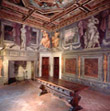|
|
Apartments in Florence, Perugia, Rome, Sorrento and Positano |




|
|
|
|
- You are in: Home » Campania » Naples
VISIT NAPLES
« All the regions
LEMON-GROVES AT SORRENTO

A typical feature of the natural environment of the Sorrento area is the famous lemon.
Sorrento lemon belongs to the species Oval Sorrento, better known as Femminello. This fruit weighs at least 85 grams, is elliptical in shape, has a strong scent and is very juicy. The yellow part of the peel is rich in essential oils and fruit juice, is a combination immediately recognizable, sugar and citric acid. In 2000, Femminello lemon received the recognition Protected Geographical Indication (PGI) from European Union. This recognition protects the species and defines the area where the lemon can be cultivated as the Sorrento Peninsula and the Island of Capri. The mark PGI also requires that the cultivation is carried out in a specific way, under the pagliarelle, which protects the fruit from salt in the air, the temperature drops and delays in the aging (which are typical of lemons). Lemons flower several times in October, the first fruit ( primofiore) gives more juicy lemons in March mature bianchetti, and in June the verdelli.
Because of their beauty filled with sunshine, lemons were initially used as decorative plants and even celebrated in rawdija (a kind of Arabic poetry). Arabs were among others who discovered the healing powers of essential oils and juice extracted from rind, flowers and fruits of laymun (lemon), narang (citrus), utrug (cedar), and so on . The distillation of al-kuhul (alcohol) through al-inbiq (still) is part of the Arab pharmacology. The addition of herbs with alcohol produces al-iksir (elixir), which for centuries were vital for doctors, chemists and monasteries. Sometimes in the fifteenth or sixteenth century, the monks began to combine alcohol scented with sweet syrups, giving it to the top of liquors and rosoli (sweet liqueurs).
top
CHURCH OF THE PIO MONTE DELLE MISERICORDIA
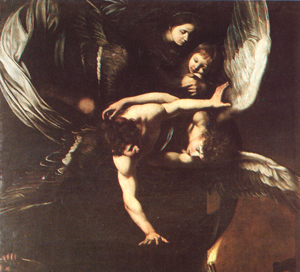
This charitable institution was founded in 1601, inspired by Counter-Reformation precepts which gave weight to such works as a way of ensuring salvation. The church is set back from the street by a five-arch loggia, where pilgrims could find shelter. The altarpiece, The Acts of Merci by Caravaggio, is a snapshot of a Neapolitan street in the 17th century.
top
SAN MARTINO MUSEUM
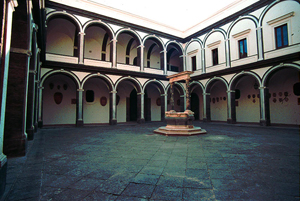
This beautiful monastery complex is located in a great spot, and its museum can attest to the wealth power the monks once enjoyed. In the 17th and 18th centuries they commissioned some of the greatest artists of those times to decorate their church and chambers in Baroque style – the church, in particular, is an enchanting catalogue of colours, and the in its museum there is a nice collection of paintings dating back to the XVII century.
top
THE RUINS OF STABIAE
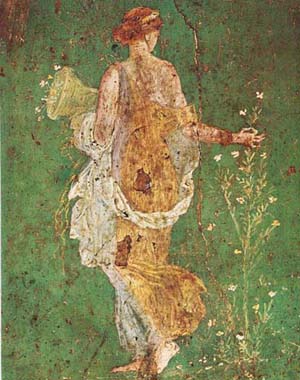
The area later occupied by the Roman town of Stabiae had been inhabited by Italian populations since VIII century b.C., as can be deduced from the necropolis discovered in the last few years; archeologists presume that one or more similar centres were founded, linked to the the others existing in the adjoining Sarno valley, and with Nucera, which here found its natural passage to the sea. But scholars still do not know in the “Samnite period” where the fortified centre rose, which was then destroyed by Silla in 89 AC during the “Social War”. The town was not rebuilt on the site of its ruins and the Roman Stabiae was mainly composed of large, luxurious villas, scattered throughout the region, above all on the brow of the Varano hill: in fact this became one of the most exclusive and residential areas of the great Roman families.
The archeological excavations began thanks to the king Charles of Bourbon and indeed they brought a fair number of villas to light, among the finest of ancient times.
In the traditional plan of that Roman period, the villas had a residential area which stretched out on the brow of the hill, with a sea view, and a rustic and service area behind it.
The planimetrical development adapted itself to the land and the most favourable orientation so that a varied, articulate construction resulted, often with more than one floor.
Gardens and peristyles played an important part in the villas and they were carefully planned by an architect to ensure that they were wide and rich, adorned with pools and fountains, with small trees and plants spread throughout. Besides the excavations have sometimes made it possible to find out their exact species. Like in the San Marco Villa there were very large private thermal bathes and large drawing-rooms. These villas had a particularly high artistic level, not only as regards the architecture, but also due to the wall paintings and stuccoes mostly executed in I A.C., very often of superior quality to similar Pompeian decorations. In addition, for the fittings recovered there, including the obsidian goblets ornated with scenes in gold polychrome and minute stone objects, is clear the residential level of this town.
top
POPPEA'S VILLAS
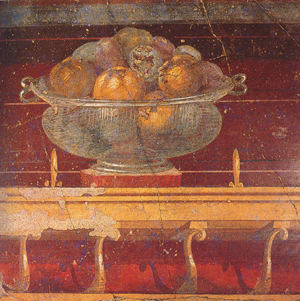
The so-called “Villa of Poppea” is perhaps the largest and most luxurious of the suburban villas so far brought to light. It lay beneath a good six metres of the usual layers of lapilli and ashes and then a thick layer of mud. The architectural complex extended for over 60 metres West-East and more than 50 metres North-South.
The first digs in the archeological area known as “Mascatelle” were undertaken in time of the Bourbon monarchy. After a short initial period of work , in 1883, when the results were very positive, later and for over a century, nothing more was done. It was only in 1964 that the present systematic excavation was begun.
DATING:
At the time that ash from the eruption of Vesuvius in 79 AD. buried the villa, it was probably temporarily uninhabited because of restoration work. Though certainly not serious, damage from the eathquake of 62 AD. may have suggested that repair work should be combined with the extension of the building. In fact, no evidence of human victims has so far been found, whilst building materials and decorative items such as columns have been discovered, massed to one side awaiting use. Examination of wall structure allows the construction date of the villa to be put somewhere in the I century BC. The modernization and extension of the thermal section and the addition of arcades and other structures on the northern side would seem to have taken place in the first years of the I century AD.
THE OWNERS:
It is difficult to say who the villa belonged to. Historical information is so scarce that even now we cannot make any firm statements. If so far it has proved impossible to say who the first owners of the villa were, some suppositions can be made about whose property it might have been in the I century AD. An amphora, found in the "latrine" of the villa bears the inscription: “SECUNDO POPPAEAE” meaning “sent to Secundus, freedman of Poppaea”. The villa had become the property of the “gens Poppaea” then, and according to some, of Poppaea herself, the wife of Nero.
THE ARCHITECTURE :
The lay-out has the essential characteristic of a Roman "domus", though in its most advanced form. Apart from the traditional living areas leading off from the atrium – the "Peristyle", i.e. a garden encircled by a colonnaded portico; the thermal complex with the "calidarium", the "frigidarium" and the "tepidarium"; the "triclinium" or dining room with adjacent kitchen; the perfectly functional "latrine". First of all we can distinguish a central block, bigger and more spacious, which runs along the North-South axis. There is a large rectangular "atrium" with finely decorated walls, in the centre of which is the "impluvium", the basin into which rain water ran and from which it was piped to the nearby cistern. After the atrium a connecting room leads to a quiet internal garden from which, through a large window, one looks into a huge room. Next to the central block lies the eastern section of the villa. The rooms there would seem to have been used either for common everyday life or as service or store rooms, and there may have been an independent entrance. At the centre of the section there is a spacious "rustic peristyle" with a fountain, and rooms of various kinds lie around it: the "lararium" is on the west side and contains an altar to the household gods; there are store rooms for food; a "tablinum; latrines" with an ingenious flushing system. The group of rooms to the west of the central block evidently had an entirely different function. This was where the owners themselves must have lived, where the reception rooms must have been. A good example is the thermal complex, next to a small tetrastyle atrium with a large circular fountain: the "calidarium" with its splendid mural decorations, the "tepidarium" and the nearby "frigidarium" all still contain the structures and technical equipment used for the heating and cooling of the water. Beside the thermal unit were situated the kitchens where a large open hearth and the sink can still be seen; then the beautiful "triclinium" with its elegant murals and a vast room .
top
THE FLEGREAN FIELDS
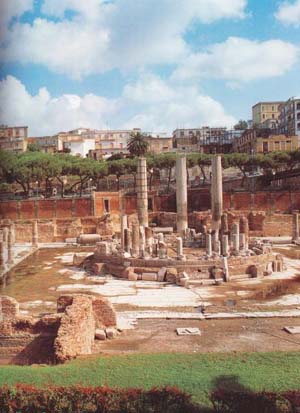
The area west of Naples is known as the Campi Flegrei (Phlegrean Fields), a classical term for the volcanic activity that has made it one of the globe’s most geologically unstable areas. The Campi Flegrei includes the towns of Pozzuoli, Baia and Cuma (Cumae) and it was partly through this region that Greek civilisation arrived in Italy. Homer believed the area to be the entrance to Hades and Virgil wrote of it in The Aeneid. Now part of suburban Naples, it bears some reminders of the ancient Greeks and Romans plus it is easily accessible, making it worth a half-day visit.
TEMPIO DI SERAPIDE (Temple of Serapis)
It was simply a market of shops and, accordino to some sources, skilfully designed toilets. It has been badly damaged over the centuries by the seismic activity known as bradyseism (slow earthquake), which raises and lowers the ground level over long periods.
SOLFATARA CRATER
Known to the Romans as the Forum Vulcani and bearing some remnants of ancient spa buildings, the crater occasionally ejects steam jets and bubbling mud. The entire crater is a layer of rock supported by the steam pressure beneath. Pick up a boulder, cast it into the air and listen to the rumblings as it hits the ground.
top
THE ISLAND OF CAPRI
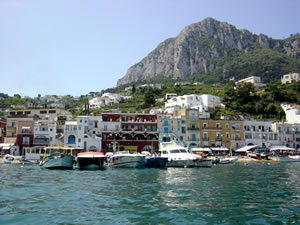
The island’s name is the subject of any number of conflicting theories; the most consistent is that it is derived from capreae (a Roman-Italic word meaning island of goats). It has been inhabited since prehistory – first by Neolithic tribes, later by the Greeks of Cumae and Neapolis (Naples). Virgil associated the place with the Teleboans, a legendary race of Greek pirates. For centuries it was more a strategic outpost than a settled community. It was not until 29 BC that Capri was touched by mainstream history, when Octavian – soon to become the Emperor Augustus – first landed on the island. So charmed was he by its beauty that he persuaded the Greeks of Neapolis to take back the already Romanised and much
larger island of Ischia and give him Capri instead, for use as a private estate. Though he never lived here, Augustus set about building villas and water cisterns, and seems to have taken an active interest in the island’s culture and traditions.
Augustus’s successor, Tiberius, ignored the place for the first part of his reign, but while on a tour of southern Italy in AD 27, he took a boat here, and never again returned to Rome. Capri was to be his home for the last ten years of his life, and the reign he established here – absolutist to the point of derangement – has been the subject of much historical embroidery. Suetonius, the scandal mongering author of De Vita Caesarum (Lives of the Caesars) depicted Tiberius as misanthropic reprobate, who liked to watch as groups of young male and female servants had sex in front of him; in case they were at a loss, the villa was well furnished with erotic statues, paintings and Egyptian sex manuals. Evidence of torture rooms, prisons and execution chambers in all Tiberius’s Capri villas testify to his other preferred form of entertainment. But Suetonius is practically our only literary source for these final years of the emperor’s life, and it has been suggested by many – most notably the British writer Norman Douglas, a long term resident of Capri – that his account is vindictive and one-sided. For Douglas, Tiberius was no monster but a bitter old recluse, happier in the company of books, works of art and astrological charts than that of human beings.
After the death of Tiberius in AD 37 the island was forgotten once more, and the 12 imperial villas gradually fell into ruin. Capri was used a couple of times as a place of exile for Roman undesirables, then came under the sway of first the Abbey of Montecassino and later of the Republic of Amalfi. Repeated Saracen attacks in the ninth and tenth centuries caused the population to move up from the main settlement of Marina Grande to the more easily defensible sites of Capri town and Anacapri. Through the Middle Ages the island followed the fortunes of Naples, passing meekly from Anjou then Aragon to Spanish rule. In the 18th century the Bourbons used Capri as a hunting reserve; the bishop of the island was know as the “bishop of quails”, as he had a right to a share of the profits on all sales of the bird. During the Napoleonic Wars the British occupied Capri as a bastion against the French Kingdom of Naples, but some brilliant decoy tactics by a French invasion force led to the recapture of the island in the space of just two weeks in 1808.
top
THE ISLAND OF ISCHIA
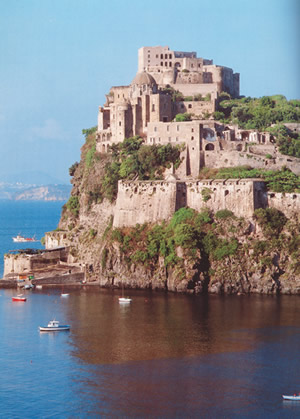
Especially loved by Germans today, the iskand of Ischia covers an area of 46.33 square kilometers
and it is the eighth largest Italian island and the largest in the Bay of Naples. Neighbouring islands
are Capri, Procida and Vivara. Known as the Emerald Isle, it is a health resort and a tourist center,
celebrated for its warm mineral springs and for its scenery. Deducing from the archaeological remains,
Ischia has been inhabited since the prehistoric age. It is sure that the island has been the first Greek
colony in the South Italy founded by settlers coming from Eubea in 800 B.C., that named it "Pithekusa"
or "Pithekusai". They settled near today's Monte Vico and called that place with the name of the crockery
that they made and that was the first economical resource of the island. In the archeoligical museum of
Lacco Ameno, we can find the most beautiful remains. The island is divided into 6 municipalities, each
one with its own administration: Ischia, Casamicciola Terme, Lacco Ameno, Forio, Barano and Serrara Fontana.
Each one has its own distinct character, governed by such factors as altitude, economy, species of
tourism, etc. The variation from town to town, district to district, means that there is something to
suit all tastes. Ischia Port is undoubtedly the hub of night life and day-tripper activity, but it is
a mistake not to move further afield, as all areas are within comfortable travelling distance.
The resident population of the whole island is 50,000.
Away from the towns, people still work the land as if they’d never seen a tourist, itself an improbable proposition.
ORIENTATION AND INFORMATION
Ferries dock at Ischia Porto, the main tourist centre. It is about a half-hour walk from the pier to Ischia
Ponte, an attractive older centre that culminates in the islet bearing the castle. The ruins of the Castello
d’Ischia, an Aragonese castle complex on a small islet that includes a XIV century cathedral and several smaller
churches, make for an interesting visit while in Ischia Ponte. Monte Epomeo (788 metres) is the island’s highest
mountain and can be reached on foot from Panza and Serrara Fontana. It offers superb views of the Bay of Naples.
Among the better beaches is the Lido dei Maronti, south of Barano.
top
HERCULANEUM
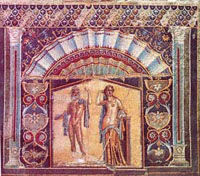
Predominantly Herculaneum was a Greek city, conquered by the Romans in 307 b. C.. Herculaneum, unlike Pompeii - essentially commercial city - had a much more genteel character, as demonstrated by the refinement of its environments and objects of excavation. The first underground explorations were conducted in 1719 by the Prince of Elbeuf, and then repeatedly between 1738 and 1766, with the discovery of famous monuments and a precious collection of papyri. It was built precisely as a result of such findings, the Real Academy Ercolanense , which, from 1755 to 1792, illustrated the rich material that came to light. Other fruitful excavations were those directed by Giuseppe Fiorelli (1869-75) and others, with rigorous scientific method, have started in 1927 and are still ongoing.
Down in the excavations, the first visit is for Theatre, Augustan construction, whose author was the architect Numizio. In the area of so-called new Excavations it is worth visiting especially the building of the Baths, the House of Genius and, before this, the House of the skeleton. Later the House of Argos, the most beautiful, who had a second plan, now collapsed, and that is preceded by a small porch and surrounded by a garden.
Among the the ancient villas in the area of Herculaneum, the Villa dei Pisoni, is very interesting. There the so-called treasure of papyri, and its sculptures were found which are now the pride of National Archaeological Museum of Naples.
top
THE CITY OF NAPLES
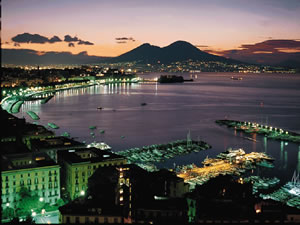
Naples is the third-largest city in Italy with a population of 800,000 inhabitants. During his visit, Goethe wrote that: “a man, who has seen Naples, can never be sad”. It is shaped in the form of semicircle, between the volcanic amphitheaters of the Flegrean fields and Vesuvius. The life and vitality of Neapolitan people give Naples the feel of a “real city” – Italy’s version of New York. Naples has a little bit of everything: the old centre, once the heart of the Neapolis of Antiquity and
now jammed with ancient churches, a medieval university and countless restaurants and cafés, pulsates to the life of noisy street
markets and their clientele, swarms of people darting about on mopeds, and the general chaos of a city at work.
Few Historycal Information
Soon after founding Cumae in 1000 b.C., colonists from Rhodes established a settlement on the west side of Mt Vesuvius and,
according to legend, named it after the siren "Parthenope". It was later known as "Palepolis", “the old city”. Later, during the
V century b.C. "Neapolis", “the new town” was founded by Greek settlers coming from Eubea. In the IV century b.C. the city fell
under Rome and became an ally of the powerful neighbouring city. Anyway Naples kept its Greek culture and due to the attractions
offered by its countryside and climate Roman nobility settled there and built splendid villas. The spread of Christianity brought
persecutions to Naples. The most famous victim was Saint Gennaro (Januarius), bishop of Benevento, who suffered martyrdom at
Pozzuoli (IV century b.C.). After that he was made patron saint of the city. The breaking up of the Roman Empire brought the
conquest by the Goths (V century) who were followed by the Byzantines. During the VIII century Naples became a self-governing
duchy and managed to preserve its indipendence. With the Norman conquest under Roger d’Altavilla (1139) the downward trend of Naples’
predominance started and the capital city of the kingdom became Palermo. After the constitution of the “Free Commune”, there was
the Swabian decline and the arrival of the Angevins. The Angevin period brought about an urban revival and marked a new development
in the cultural life. Under the Aragonese rule the city took part in the dispute between the Spanish and the French, but the
subsequent Spanish rule was one of the most troublesome periods in the history of Naples, marked by frequent uprisings by the
population (that of Masaniello in 1647 is famous) and tormented by epidemic of the plague. Later conquered by the Austrians and
delivered to Charles of Bourbon, Naples regained its former splendour as capital of an autonomous kingdom (1734). In 1860 Garibaldi
invaded and joined it to Piedmont.
WHAT TO SEE
Naples streches along the waterfront and is divided into "quartieri" (quarters) – most street signs bear the name of the quarter as well.
The main train station , "Stazione Centrale", and bus station are off "Piazza Garibaldi", just east of "Spaccanapoli", the old city.
A wide shopping street, "Corso Umberto I", skirts the southern edge of "Spaccanapoli", the ancient heart of Naples, on its way
south-west from "Piazza Garibaldi" to "Piazza Bovio" and on the huge "Piazza Municipio", which is dominated by the "Castel Nuovo".
From the waterfront directly behind the castle you can find boats to the bay islands, Palermo and other long-distance destinations.
The "Royal Palace", the former royal palace, is next to the castle. From the palace, head north for Naples’ main street, "Via Toledo",
wich becomes "Via Roma" for a short stretch after it crosses "Piazza CaritĂ ", and you will reach "Piazza Dante", on the western boundary
of "Spaccanapoli". The road continues as "Via Santa Teresa degli Scalzi" and then "Parco di Capodimonte" north of the centre.
The extensions of two of Naples’more original streets, via "Benedetto Croce" (which becomes "Via San Biagio dei Librai) and "Via dei
Tribunali", eventually meet "Via Roma". Most street life and many of the city’s artisans can be found in this area. "Via San Biagio dei
Librai" is part of an almost straight run from near the "Stazione Centrale" through "Spaccanapoli" to the foot of the hilltop Vomero district.
On the bay to the south-west are the more fashionable area of "Santa Lucia and Mergellina", with its semi-grand waterfront boulevard,
"Via Caracciolo" (from where more boats head for the islands). Rising up from "Mergellina" is the up-market "Vomero" district, dominated
by the "Castel Sant’Elmo" and the "Certosa of San Martino", a Cartusian monastery which can be seen from all over the city.
top
THE ROYAL PALACE OF NAPLES
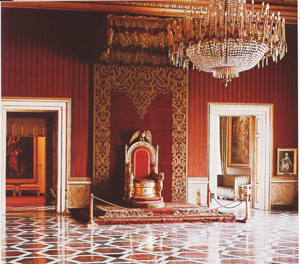
The Royal Palace of Naples was built as the king of Spain Philip III was supposed
to be coming to visit Naples and it was felt that the other royal residences were not
suitable for a king to stay in.
The Royal Palace was designed by Domenico Fontana at the beginning of the XVII century as
the viceroy Ferrante di Castro wanted to be built. But in the XVIII century it was restored
by Luigi Vanvitelli. Some of the arches of the façade were filled with niches as the
architect Vanvitelli thought that the palace was in danger of collapsing as it wasn’t stable.
Later Gioacchino Murat and Carolina Bonaparte decorated the royal palace with neoclassical
furniture and porcelain (China ware). In 1837 a fire broke out and damaged the building.
That is the reason why it was restored by Gaetano Genovese. It was damaged also during the
last war and then it was renewed once again. In 1888 the king of Italy, Umberto I placed in
the arches of the façade 8 statues representing the most important kings of the various
dynasties who ruled Naples over the centuries: Roger the Norman, Frederick II of Swabia,
Charles I of Anjou, Alfonso I of Aragon, Charles V of Spain, Charles of Bourbon, Joachim Murat,
Victor Emanuel II.
Nowadays its first floor has been transformed into a museum and it houses the National Library.
As regards the museum, it is difficult to describe each room, but noteworthy in particular are
the Theatre, The throne Room and the Great Capitan’s Room..
The Theatre:
It was the Old Ball Room turned into the Royal Theatre by Ferdinando Fuga in 1768. Half
destroyed by a bomb during the last war, it was restored in the middle of this century.
It was transformed into the Royal Thetre when the king Ferdinand IV of Bourbon married
Maria Carolina of Austria. It is decorated in rococò style and the paper-pulp statues
surrounding the hall represent the Muses, Minerva, Apollon and Mercury. In 1994 the G7
members met in that room.
The Throne Room:
The Throne room is in Empire style and dates back to the year 1850. In the vault there are
14 female figures symbolizing the various districts of the Bourbon Kingdom. In front of
the throne there is portait of Ferdinand I of Bourbon who is pointing out the church of
San Francesco di Paola, which is in front of the Royal Building. On the right and on the
left of the throne two paintings represent the ambassadors of Tripoli and of Turkey.
In the same room another painting showes Victor Emanuel III, king of Naples, when he was
a boy: he was born in that building in 1869.
The chandelier is made of crystal from Bohemia.
The Great Capitan’s Room:
This room is dedicated to Don Salvo de Cordoba, the Spanish capitain who conquered the
Kingdom of Naples in 1503. Since then Naples was no longer the capital of the kingdom but
just the capital of one of the Spanish dominions.
The vault was painted by Battistello Caracciolo and it represents the great capitain.
In the same room a precious portait of Pier Luigi Farnese by Tiziano Vecellio is kept.
top
THE RUINS OF POMPEII
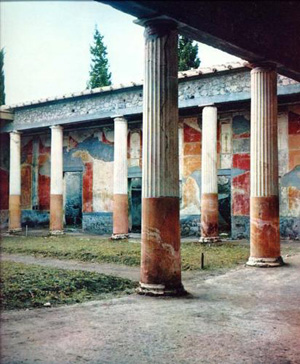
Nowadays Pompeii is one of the most famous and visited archaeological sites in the world.
The origin of the city is uncertain: the oldest reports date back to the 7th century B.C.
In Roman times its ideal location and its magnificent scenery led many wealthy Romans to build villas there.
Unfortunately the city was much damaged by an earthquake in 62 A.D and on the 24th August of 79 A.D. was completely demolished by an eruption of Mount Vesuvius together with the ancient Roman resort towns of Herculaneum and Stabiae.
Even the memory of its exact location was lost over the centuries.
For more than 1500 years Pompeii has been buried undisturbed beneath heaps of ashes and cinders until it was rediscovered in 1748.
Among the most significant aspects of the discoveries at Pompeii is the remarkable degree of preservation of the ancient objects.
The showers of wet ashes and cinders that accompanied the eruption formed a hermetic seal on the town, preserving many public structures, temples, theaters, baths, shops, and private dwellings.
In addition, remnants of some of the 2000 victims (about 5,000 people lived in the city at the time of the eruption) of the disaster were found in the ruins of Pompeii, including several gladiators who had been placed in chains to prevent them from escaping or committing suicide.
Ashes, mixed with rain, had settled around the bodies in moulds that remained after the bodies themselves had turned into dust.
In the years 1860-75 Giuseppe Fiorelli takes charge of the excavations, developing a technique of casting bodies.
Fiorelli's masterstroke was to devise a method of injecting plaster into the spaces left vacant by the flesh as it decomposed, enabling him to recover the shapes of the bodies as they had fallen.
We have also learned much about how they died during the eruption.
There are numerous moulds of people in their final moments.
Moreover to simplify study and orientation, Fiorelli divided the city into regiones (neighbourhoods) and insulae (blocks).
Today the city with its buildings, the temples, the streets with the ruts made by chariot wheels in the paving blocks, even the walls with inscription of various type, tell astounded visitors the story of ancient Roman everyday life.
The Ruins of Pompeii are open:
From April to October - from 8.30 am to 7.30 pm , but visitors can access the excavations till 6.00 pm
From November to March - from 8.30 am to 5.00 pm , but visitors can access the excavations till 3.30 pm
top
NAPLES ARCHAEOLOGICAL MUSEUM
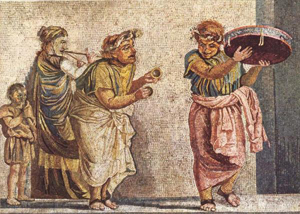
The works of the building that houses the Archeological Museum of Naples carried out between 1582 and 1586 by order of the Duke of Ossuna and designed by the architect Giulio Cesare Fontana.
It had to be the Royal Riding School, but when they realized that there was no water in that place, the stable was abandoned.
In 1615 it was inaugured as the "Palace of Royal Studies", the seat of the University of Naples.
When the university moved elsewhere in 1777, King Ferdinand IV commissioned the restauration of the building from the architect Ferdinando Fuga in order to adapt it to accommodate the Bourbon Museum and Royal Library.
In 1797 this building housed the Herculaneum Museum, the Picture Gallery and the very famous Farnsese Collection which Charles of Bourbon inherited from his mother Elisabetta Farnese, wife of Philip, in 1731.
During the XVIII and the XIX centuries the museum continued to receive a lot of artifacts, both from private collections and from excavations of Pompeii, Herculaneum, Stabiae, Paestum, Cuma or elsewhere in Southern Italy.
These archaeological treasures represent one of the most comprehensive and complete Greek and Roman collections in the world.
The musuem could be divided into different sections:
- Marble and bronze statues: worthy of note are “The Lance bearer” by Policletus, Farnese Hercules, the bas-relief of Orfeus and Eurydice, Farnese Bull.
- Collection of gems
- Egyptian section
- Mosaics: this section is one of the most important in the world: we can mention in particular the biggest mosaic floor in the world “TheBattle of Alexander”, the biggest mosaic floor in the world representing great Macedonian emperor. Once it paved the floor in the Casa del Fauno at Pompeii. In addition other mosaics portraying animals, scenes from every-day life, musicians and even Plato with his students are kept.
- Section dedicated to the “Pisoni Villa” where statues from that big dwelling are kept
- Silverware, glazed earthenware and weapon collection
- Frescos mostly coming from the ruins of Pompeii, Herculaneum and Stabiae
- Vases
Museo Archeologico Nazionale
Piazza Museo tel.081440166
orario :
feriali 9.00 - 19.30
festivi 9.00 - 19.30
la biglietteria chiude alle ore 18.00
chiuso il martedì
ingresso: euro 6,50 per i visitatori dai 18 ai 65 anni,gratuito per gli altri
The Naples Archaeological Museum is recognized as having the finest and most complete collection of works of art, objects and documentation from classical times.
This collection includes over 20,000 items, produced according to object type and in inventory sequence.
Items include bronzes, ceramics, sculpture, wall paintings, jewellery, terracotta items, objects in gold and silver, ivories, mosaics, utensils, Latin inscriptions and frescoes.
The collection depicts portraits, still lives, mythical subjects, scenes from daily life, and erotic works of the museo segreto.
It documents beliefs, personalities, religions and views of the outside world.
top
THE MUSEUM OF CAPODIMONTE
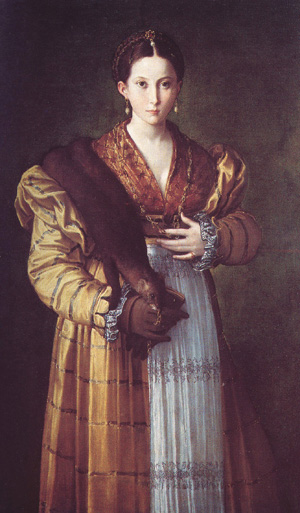
Conceived as a country house, the Royal Palace of Capodimonte assumed the stature of a Royal Palace, enriched by a magnificent park, whose avenues were designed by the great Neapolitan architect Sanfelice. When Charles inherited the marvellous Farnese collection from his mother, Elisabeth Farnese, he wanted to place it in the new palace. Built in 1816, a great part of the collection was transferred to the National Museum, where the paintings, bronzes and Pompeii statues stood. Now the collection has been restored to its original home, so leaving more space for the archeological collection of the National Museum.
After the last war, the future of the great Royal Palace, immersed with its red-grey immensity in the XVIII century park, seemed uncertain. No one had lived in it since the accession of the House of Savoy, when it had been assigned to the house of Aosta. The idea of installing the Aeronautic Academy was proposed, and it was suggested breaking up the park and disfiguring the monumental building of great importance. The Superintendent of Works of Art for Campania, Bruno Molajoli, conducted a lively campaign to use the palace as a museum, making it an art gallery worthy of Naples, transporting the pictures that crowded the Museum, which for its part needed more space to devote to its own archeological collection. The idea was agreed to and Naples now has one of the most modern museums in Europe set in sumptuous surroundings, with the most functional lighting, heating and restoration facilites. It seems as though we are back in the times of Charles of Bourbon, when the site of Capodimonte seethed with art, and the activities of the porcelain factory, which was in the park itself, made the name of Capodimonte famous.
There are hundred rooms, restored and rearranged, as well as the picture gallery. Among the pictures are the monumental Crucifixion by Masaccio, Botticelli’s Madonna with Angels, the famous Gypsy by Correggio, Giambellino’s Transfiguration, Sebastiano del Piombo’s Clement VII, and the wonderful portraits by Parmigianino and Titian. There are also works by Raphael, Pinturicchio, Luca Signorelli, Goya, Perugino, Simone Martini, Colantonio, Bruegel. In addition to the classic paintings there is a copious collection of the XIX century Neapolitan art, with Gigante, Migliaro, Mancini, Michetti and others. Also there are collections of Renaissance armour, ivory, crystal and the famous porcelain salon: a room whose walls are entirely covered in porcelain, with a great chandelier hanging from the ceiling, shattered by bombs and miraculously reconstructed.
Today thousand of rare and precious objects present the visitor with a wonderful variety; and when the eye has had its fill of the wonders of art, one has merely to step on to the tufa balconies and breathe the pure air of the Park, and gaze upon the sea in the bay, between the tall trees.
The Museum was opened in 1957 and is not yet widely known throughout the world; but those who have visited this surprising and delightful place have realised that, with this achievement, Naples has been able to reaffirm its cultural tradition.
The rest of the rooms with their comfortable settees, smoking room, heating and electrical ventilation, modern lifts, bar and panoramic terrace, all go to make the visit to the hundred rooms of the Museum a pleasant one. The Museum’s picture restoration rooms are among the finest in Europe.
top
SANSEVERO CHAPEL

According to the historian Cesare d'Engenio (1642), this chapel was probably first built around 1590.
At this time Giovan Francesco di Sangro, Duke of Torremaggiore, had just had a serious illness and he
had the little chapel built to the Virgin of Mercy in his garden in sign of gratitude for his recovery.
In 1608 Alessandro di Sangro, son of Giovan Francesco, had the chapel enlarged "because it was not able
to hold all the people who came to see the endless miracles performed there". The chapel also became a burial
place for members of the family, in addition to being a place of worship.
Little is known about the chapel in the XVII century, because the building as it is now dates back to
Raimondo di Sangro's alterations carried out in the XVIII century, which were so extensive as to change
the previous decor. The name of the architect who originally directed the works is unknown, but he probably
followed the wishes of his client, as the simplicity of the rectangular plan without a real apse, and the
large number of statues and decorative items would lead one to suppose that there was no specific plan.
There was probably much of the typical XVII century love for decoration in the chapel, as Pompeo Samelli
remarks in 1697 that the chapel is "pleasingly enriched with very fine work in marble, and with statues of
many famous members of the family and their epitaphs".
The most interesting period in the history of the chapel starts around 1742. Prince Raimondo di Sangro,
(1710-1771) who personally supervised the alterations, perfectly embodied the spirit of the century where he lived.
A particularly skilful soldier, a scientist and alchemist, his insatiable curiosity caused him to become a legend in his time.
In 1749, the artist Francesco Maria Russo completed the great fresco on the ceiling and the trompe-l'oeil
decoration with medallions in tones of green of the six Saints in the family. Russo also designed the statue
of Raimondo di Sangro which stands at the entrance to the underground cavea.
In the middle of the presbytery is the extremely large and theatrical work by Francesco Celebrano, the
Deposition, made like a "painting in marble", and on both sides are Chastity by Antonio Corradini (left),
and Disenchantment by Francesco Queirolo (right). The former was made when the sculptor, who was famous
all over Europe, came to Naples at an advanced age - he was, in fact, to die the following year. It has been
said that this work, notable for its sensuality, is more suitable for an art-gallery than a church, although
it is supposed to represent the great virtue of Cecilia Gaetani, the Prince's mother; the blend of holy and profane
thought, was the most remarkable artistic feature of this period.
The second sculpture, by the Genoan Francesco Queirolo, is real virtuos work: he fashioned a net thrown over
a male figure trying to get out of it, and this must have been an incredibly difficult task.
The last sculpture is certainly the finest and has become the simbol of the chapel - the Veiled Christ by
Giuseppe Sanmartino. Until the recent discovery of the original sketch for this sculpture (made in 1753), it
was attributed to a sketch by Corradini. It is now known that Sanmartino, a Neapolitan sculptor, was commissioned
to make this piece and that it was to be placed in the cavea, illuminated from above by the "eternal lamps" invented
by the Prince and not where it is placed now - in the centre of the nave. With the original position in mind, Sanmartino
studies the effects of light on the intricate folds of the shroud covering the body, lying on the cushions. In this
superb play of light and shadow, death is no longer seen as a painful separation from life, but as a poetic moment.
This poetry originated from the sculptor's amazing technical skill, which can be seen in many of the works made
during his long career. This sculpture is one of his early ones, and the languid atmosphere of pre-Romanticism
can be strongly felt here. So striking was this piece, that another famous sculptor - Antonio Canova - wanted
to buy it during a visit to Naples, but fortunately for Naples that purchase was never made.
top
|
|
|
|
|
|
| TOP DESTINATIONS
|
| Adria Coast, Aeolian Islands, Alessandria, Altopiano Delle Rocche, Amalfi Coast, Aosta, Assisi, Asti, Bari, Brescia, Capo Vaticano, Capri, Catanzaro, Chianti, Cilento, Cinque Terre, Coast Of Marche, Conero Coast, Dolomites, Egadi Islands, Elba, Florence, Garda Lake, Gargano, Ischia, Italian Riviera, Lake Como , Langhe Piedmont, Lecce, Lucca, Lunigiana, Macerata, Mantova, Maremma Tuscany, Monferrato, Montepulciano, Naples, Perugia, Pesaro Urbino, Pisa, Pistoia, Positano, Prato, Procida, Riviera Of Palms, Rome, Salento Coast, Salerno, San Gimignano, Sardinia, Sicily, Siena, Sorrento, Terni, Tiber Valley Of Tuscany, Treviso, Turin, Val Gandino, Veneto, Venice, Viterbo |
|
|


















